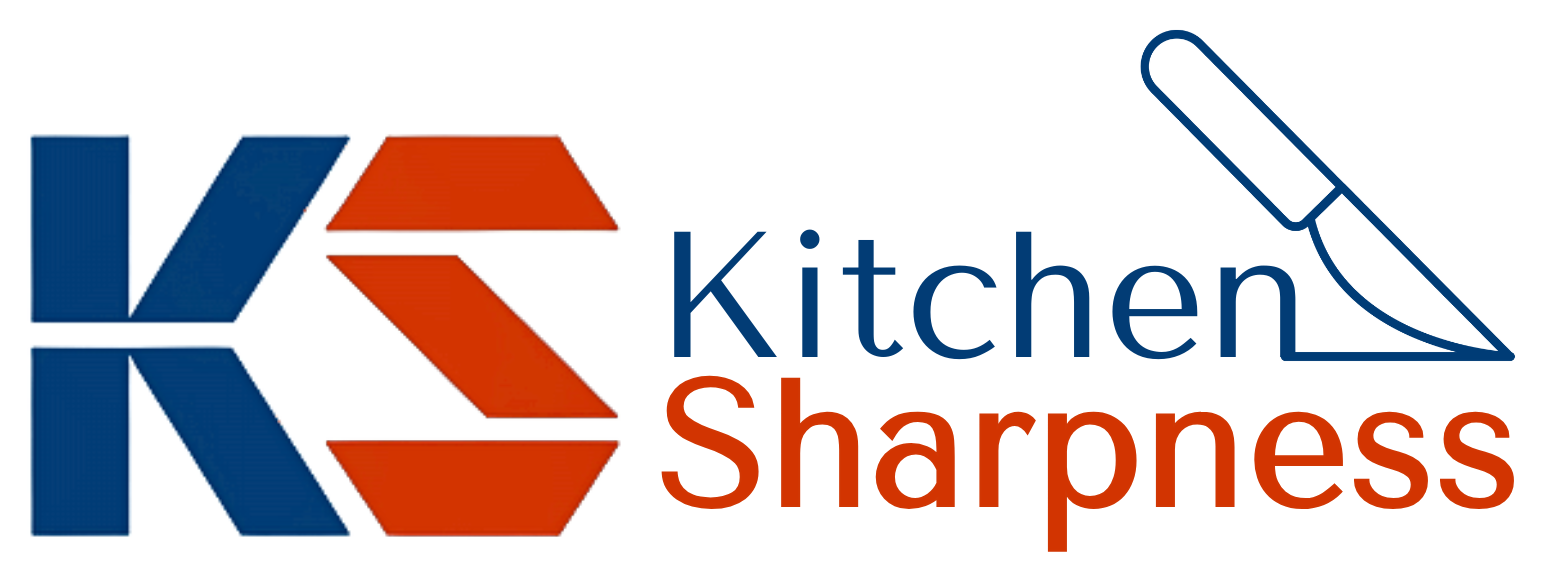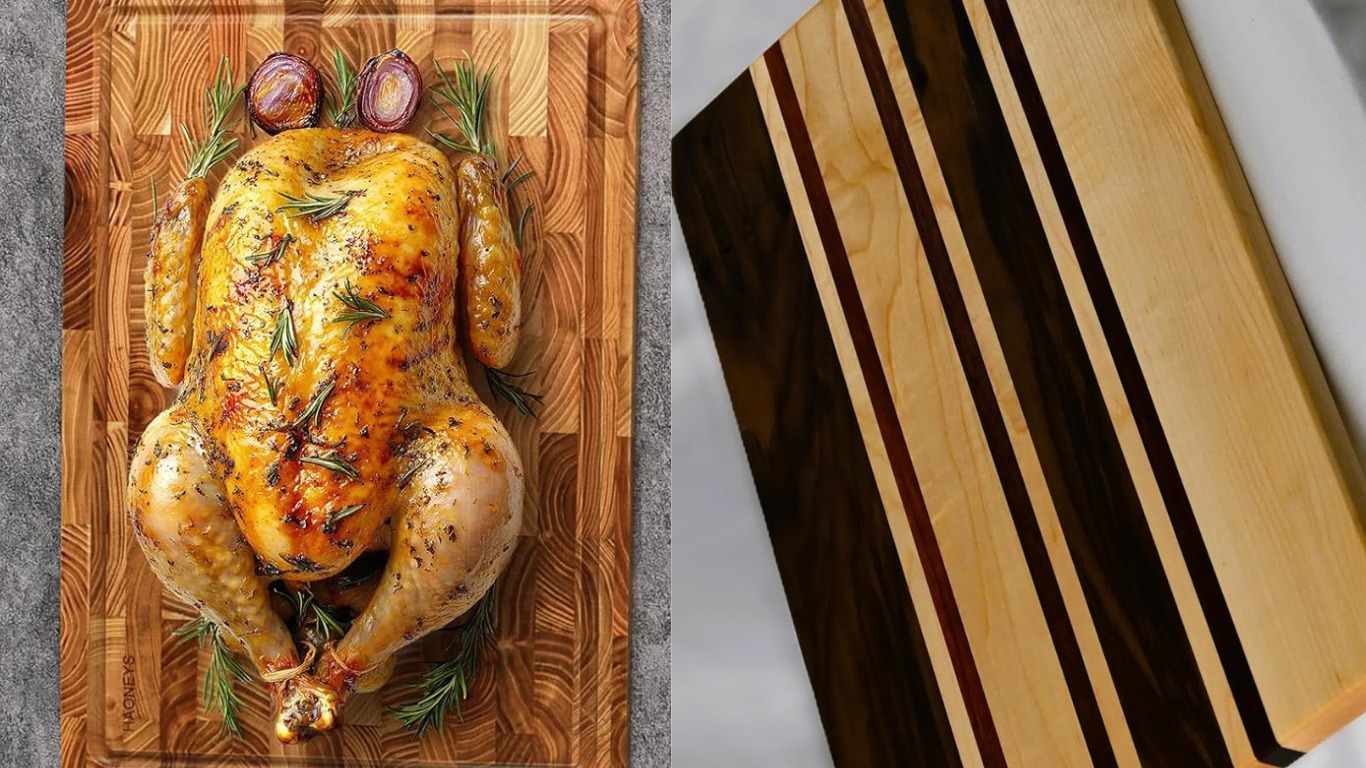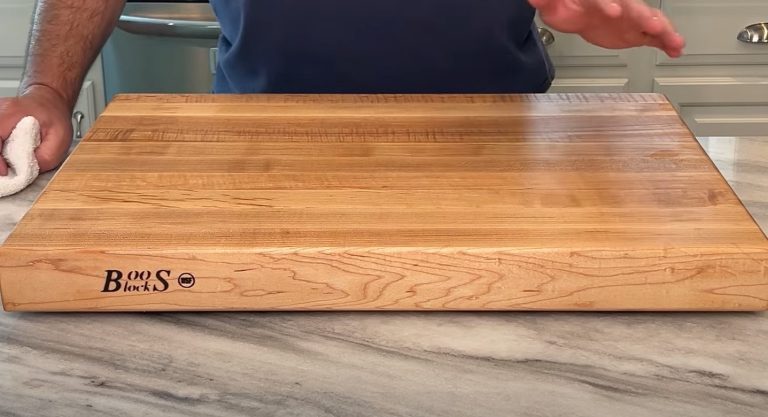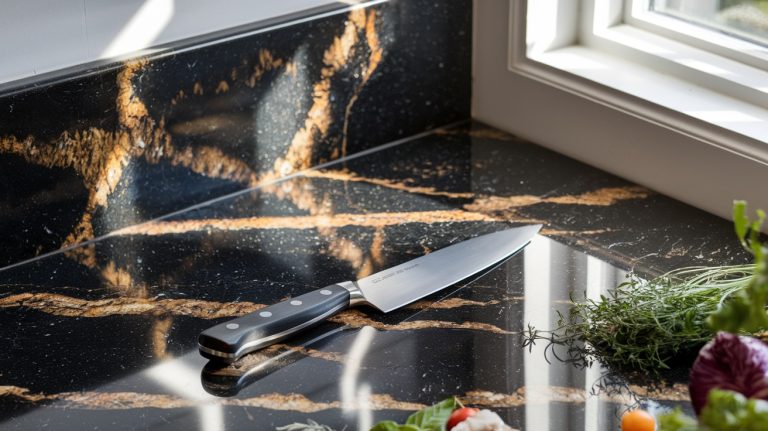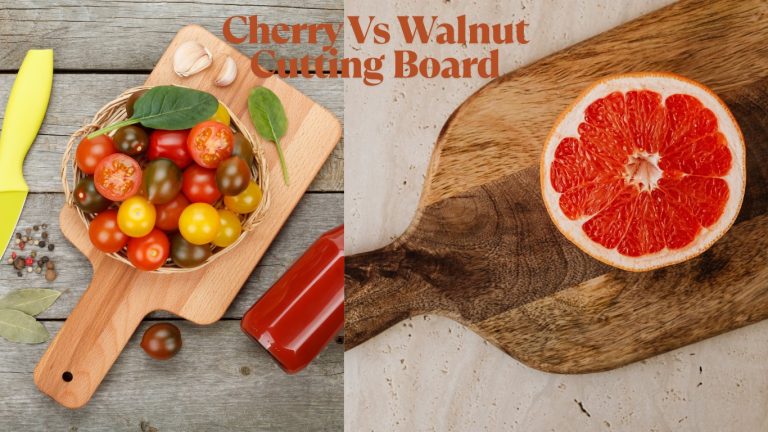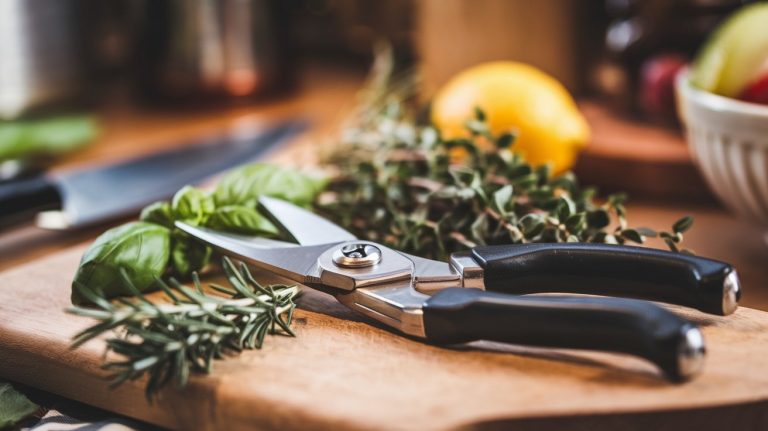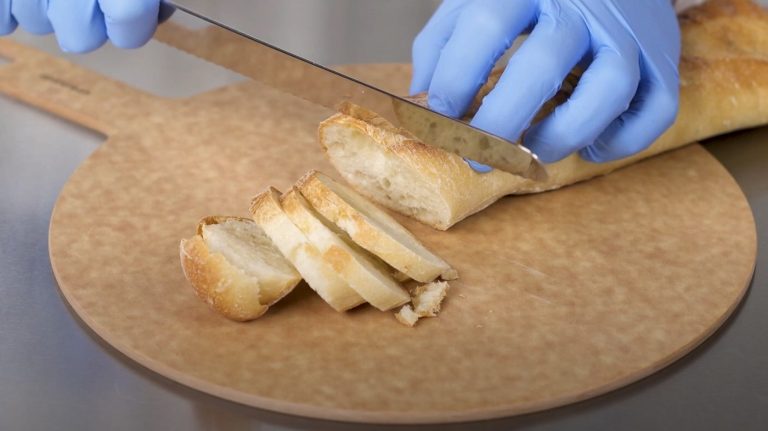End Grain vs Face Grain Cutting Board: What’s the Difference?
When choosing between end grain and face grain cutting boards, you’ll notice key differences. End grain boards, with vertical fibers, protect your knife edges by letting blades slide between fibers, reducing dulling, and offer self-healing surfaces.
Face grain boards, with horizontal fibers, cause faster blade wear and show more scars. End grain designs are thicker and heavier, while face grain ones are lighter and simpler. Stick around to uncover deeper insights into their unique benefits.
Key Takeaways
- End grain boards have vertical fibers, reducing knife dulling and offering self-healing properties.
- Face grain boards have horizontal fibers, causing faster blade wear and visible scars.
- End grain boards are thicker, heavier, and more durable but require frequent oiling.
- Face grain boards are thinner, lighter, and easier to maintain with less upkeep.
- End grain boards cost more due to complex, labor-intensive production processes.
Construction and Design Differences
When exploring the construction and design differences between end grain and face grain cutting boards, you’ll notice distinct approaches to how each is crafted.
With face grain boards, you’re working with the widest lumber face as the cutting surface, gluing long strips edge-to-edge for a simpler, less labor-intensive process.
This results in thinner, lighter boards showcasing continuous grain patterns and a classic, smooth appearance. Additionally, face grain boards are limited to a maximum thickness of 1-3/4″ thick due to the constraints of the original board’s dimensions.
In contrast, end grain boards use the wood’s cross-section as the surface, requiring a multi-step process.
You’ll glue blocks together, cross-cut panels into strips, rotate them, and re-glue, creating thicker, heavier boards.
This labor-intensive method yields striking checkerboard or mosaic designs, exposing growth rings and allowing intricate patterns with varied wood species. Moreover, end grain boards often provide enhanced durability through their construction, making them ideal for heavy use.
Impact on Knife Edges and Durability
Building on the distinct construction methods of end grain and face grain cutting boards, let’s examine how these designs affect knife edges and overall durability. Unlike hard surfaces such as marble, end grain boards are gentler on knives due to their forgiving structure.
When you use an end grain board, the vertical wood fibers part as your knife slides between them, reducing dulling.
Face grain boards, however, present horizontal fibers, so you’re cutting across them, accelerating wear on your blade.
End grain’s self-healing nature lets fibers close after cuts, minimizing visible marks, while face grain shows scratches readily.
Durability-wise, end grain’s higher hardness (e.g., 622 kgf/cm2 vs. 463 kgf/cm2 for face grain) and wear resistance make it ideal for heavy chopping.
Though quality face grain can last 5-10 years, end grain typically outlasts with its robust construction.
Additionally, end grain boards are less prone to warping and cracking, even with frequent moisture exposure, enhancing their longevity less prone to warping.
Maintenance Needs and Care Tips
Proper maintenance of your cutting board, whether end grain or face grain, is essential to guarantee longevity and hygiene. After each use, wash it with warm water and mild soap, scrubbing knife marks with a sponge.
Rinse thoroughly and dry immediately with a clean towel. Store it upright in a cool, dry area for air circulation. For added durability, incorporate a beeswax blend into your maintenance routine to provide extra moisture protection.
Oil your board monthly with food-grade mineral oil or specialized conditioner, applying generously when dry and wiping off excess after soaking overnight.
For stains, use lemon juice or a baking soda paste, rinsing well after. If scratches appear, sand with the grain using 80 to 220-grit sandpaper, then re-oil deeply. Consistent care guarantees your board’s durability and performance.
Sanitation and Moisture Considerations
Let’s shift focus from maintenance routines to the essential aspects of sanitation and moisture management for your cutting board.
You’ll notice end grain boards absorb moisture up to 100 times faster due to their straw-like fibers, making them prone to warping if you wash only one side or skip regular oiling.
Face grain, though less absorbent, still warps easily, especially in thinner boards, as knife scars trap moisture and bacteria.
End grain’s capillary action wicks bacteria away, potentially killing them, while face grain’s grooves harbor contaminants if not cleaned thoroughly with hot, soapy water. Moreover, bamboo cutting boards offer antimicrobial properties that help inhibit bacterial growth more effectively than some other materials.
Always wash all sides, dry completely, and oil both types to block moisture and bacteria.
Neglect these steps, and you’re risking bacterial growth and board damage.
To prevent cross-contamination, consider using separate boards for raw meats and ready-to-eat foods separate boards usage.
Cost Factors and Production Insights
When diving into the cost factors and production insights of cutting boards, you’ll quickly notice stark differences between end grain and face grain designs.
End grain boards demand more material, often starting with thicker lumber like 8/4 stock, and involve complex processes with multiple glue-ups and cuts.
You’ll find their labor-intensive nature—requiring days for glue drying and high skill for flatness—drives costs into the $100-$300+ range. For instance, art-inspired end grain boards can even reach prices like $425 for special designs special designs.
In contrast, face grain boards use less wood, relying on simpler edge-to-edge glue-ups of wide planks.
You’ll see faster production, often just hours, with minimal stages, keeping labor costs low and prices more affordable.
Material type and board size further impact costs, with end grain amplifying these expenses due to greater material needs, and Acacia wood often provides a more budget-friendly option due to its lower price per square foot.
Key Advantages and Drawbacks
As you evaluate end grain and face grain cutting boards, consider how each impacts knife edge longevity.
You’ll notice that end grain’s vertical fibers allow your blade to slip between them, minimizing dulling and reducing sharpening frequency, while face grain’s horizontal fibers cause faster wear on your knife’s edge.
Additionally, think about maintenance effort, as end grain demands more frequent oiling due to its absorbent nature, whereas face grain requires less upkeep with its lower porosity.
Also, keep in mind that end grain boards often have self-healing properties from cuts, which can extend their lifespan compared to face grain boards.
Moreover, opting for wood types with antimicrobial properties can help reduce the risk of foodborne illnesses when using end grain boards.
Knife Edge Longevity
Precision in maintaining your knife’s edge starts with understanding the impact of cutting board grain orientation.
When you use an end grain board, the vertical fiber alignment lets your knife slide between fibers, reducing friction and wear.
This preserves sharpness, minimizes dulling, and lowers sharpening frequency.
The fibers often close back after cuts, acting almost self-healing against blade damage.
Conversely, with face or edge grain boards, your knife cuts across horizontal fibers, increasing resistance and abrasion.
This severs fibers permanently, dulls edges faster, and demands more frequent sharpening.
The surface scars visibly, reflecting the direct impact on your blade.
While some studies suggest minimal differences in specific woods, end grain generally offers superior knife edge longevity for consistent performance.
Additionally, the unique vertical orientation of end grain boards provides greater strength and stability during heavy use, and for materials like rubberwood, this benefit is amplified by its tight grain structure.
Maintenance Effort Needed
Moving from the impact on knife edges, let’s explore the maintenance demands of end grain and face grain cutting boards. You’re tasked with more effort for end grain boards; they need frequent oiling every few weeks to prevent drying and cracking, and their vertical fibers absorb moisture easily.
Cleaning’s meticulous—hand-wash all six sides, no dishwasher. Face grain boards, however, are simpler. You’ll oil less often, and their lighter weight eases handling, though knife scars show more and may need sanding.
Additionally, end grain boards require consistent care to avoid warping due to their moisture-sensitive fibers, and for optimal protection, applying a food-safe sealant regularly can help maintain the board’s integrity. Check the table below for a quick comparison.
| Aspect | End Grain |
|---|---|
| Oiling Frequency | Every few weeks |
| Moisture Absorption | Higher |
| Cleaning Effort | More detailed, all sides |
| Weight for Handling | Heavier |
| Surface Restoration | Self-heals, less sanding needed |
Frequently Asked Questions
Can End Grain Boards Handle Heavy Chopping Tasks?
Hey, if you’re wondering whether certain cutting boards can tackle heavy chopping tasks, you’ve gotta look at their design.
Opt for boards with vertical wood fibers that absorb impact like a champ, reducing wear.
You’ll find they resist cracking or splitting, even under intense use.
With thicknesses up to 4.5 inches, they’re stable and heavy, ensuring durability.
Trust me, they’ll handle your toughest kitchen challenges without breaking a sweat!
Are Face Grain Boards Suitable for Professional Chefs?
Hey, imagine your kitchen as a battlefield—every chop a strike in the war of flavors!
Now, let’s tackle if face grain boards suit professional chefs like you.
They’re crafted with horizontal wood fibers, showcasing stunning grain patterns, but they’re not tough enough for heavy-duty slicing.
Knife marks show easily, durability lags, and warping’s a risk with uneven moisture.
For intense culinary combat, you’ll likely need a sturdier ally.
Do End Grain Boards Come in Different Wood Types?
Hey, you’ll find that end grain boards are crafted from a variety of wood types, each offering distinct properties.
Choose hardwoods like Maple for tight, closed grain and durability, or Walnut for its knife-friendly hardness and rich color.
Opt for Cherry if you want a softer touch with deepening hues.
You’ve also got options like exotic Purpleheart for striking visuals, or Ash for strength—tailor your pick to specific needs!
How Do Face Grain Boards Affect Food Flavors?
Hey, when you’re using a cutting board, you’ve gotta watch how it impacts food flavors.
Face grain boards absorb moisture quickly due to their softer, open-pored structure, trapping juices and odors like garlic or onion.
Knife cuts on the surface snag food particles, fostering bacteria and flavor transfer.
You’ll need to clean thoroughly, oil regularly with food-grade mineral oil, and use vinegar or lemon to neutralize lingering smells.
Are End Grain Boards More Eco-Friendly to Produce?
Hey, when you’re evaluating if a production process is eco-friendly, delve into the specifics of material and energy use.
You’ll find that crafting certain wooden products consumes more resources due to thicker designs and complex steps.
Expect higher wood consumption and labor intensity, with multiple cutting and gluing stages driving up energy costs.
However, using scrap wood can offset waste, potentially tipping the balance toward sustainability if managed efficiently.
End Grain or Face Grain—The Smart Choice for Your Kitchen
As you weigh end grain versus face grain cutting boards, picture end grain as a sturdy fortress, absorbing knife strikes with resilience, protecting your blade’s edge like a seasoned warrior.
Face grain, however, acts as a sleek, polished shield, offering affordability but wearing down faster under heavy use.
Choose end grain for durability and knife care, or face grain for budget-friendly ease—just make sure you maintain either with precision to keep bacteria at bay.
